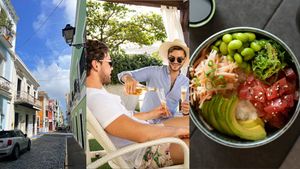Around 300,000
revelers cheered as a sequins-sparkling, 10,000-strong
parade sashayed down inner-city streets Saturday in Sydney's
30th annual Gay and Lesbian Mardi Gras. In-depth
blogging of the debauchery from The
Advocate's Sean Kennedy and Kyle Buchanan is
available here.
What began in
1978 as a protest march by 1,500 brave gay, lesbian, and
transsexual men and women that was harshly disbursed by
police has grown into one of the world's largest and
most flamboyant gay pride events.
This year's
procession of 150 floats was led by the ''78ers'' -- a group
of 186 of the original marchers and their partners, who drew
rapturous cheers.
Diane Minnis, a
Sydney woman in her 50s who was among the pioneers, said
she never envisaged that their protest against
discrimination would evolve into the annual,
multicolored celebration of today that parties on well
into the daylight hours of the following day.
''But we're very
glad that it did because it makes being gay, lesbian,
transsexual, etceteras, very visible, and that's what we
still need,'' she said.
Organizers have
described this year's Mardi Gras as the largest yet,
drawing thousands of tourists from across the nation and
around the world.
Much of what the
original protesters railed against has crumbled and the
event has become increasingly mainstream.
Gay troops
marched for the first time under an officially endorsed
Defense Department banner, and a band of Christian clerics
joined the parade to distance themselves from
colleagues who make moral judgments.
State laws
banning homosexual acts have been repealed throughout
Australia since 1978. But the revolution continues, with the
federal government's antidiscrimination commission
using the event to highlight that same-sex couples
fall short of heterosexuals in tax and pension
benefits. (AP, with additional reporting by The
Advocate)

















































































